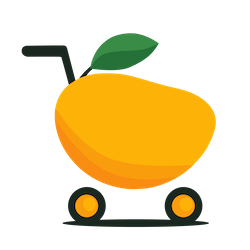Turn “too technical” → “take my money”.
You’re going to get:
12 Templates:
- The 15-Min Method (Day 1-3)
- Feature-Benefit-Proof connector worksheet (Day 4-6)
- Technical buyer persona worksheet (Day 7-10)
- 12 questions for SME interviews (Day 11-13)
- 5 headline formulas for technical products (Day 14-16)
- Technical complexity assessment scorecard (Day 17-20)
- Product Page template (Day 21-23)
- Email Campaign template (Day 21-23)
- Case Study template (Day 21-23)
- White Paper template (Day 21-23)
- Technical review process template (Cross-Team Collaboration Blueprint)
- Tech Copy Scoring Matrix (Tech Copy Scoring System)
12 Processes:
- How to extract important features from technical documentation (Day 1-3)
- The “So what?” method for finding benefits (Day 4-6)
- How to identify technical knowledge levels (Day 7-10)
- The 30-minute technical interview process (Day 11-13)
- How to adapt copywriting frameworks for technical offerings (Day 14-16)
- 3-step method to replace jargon with plain language (Day 17-20)
- How to apply templates to different channels (Day 21-23)
- How to run a 5-person clarity test (Day 24-26)
- The 15-minute emergency fix method (Day 27-30)
- How to create “good enough” technical content quickly (Minimum Viable Framework)
- How to select the right visualization for technical concepts (Tech-to-Visual Guide)
- How to audit existing materials in 60 minutes (Tech Copy Scoring System)
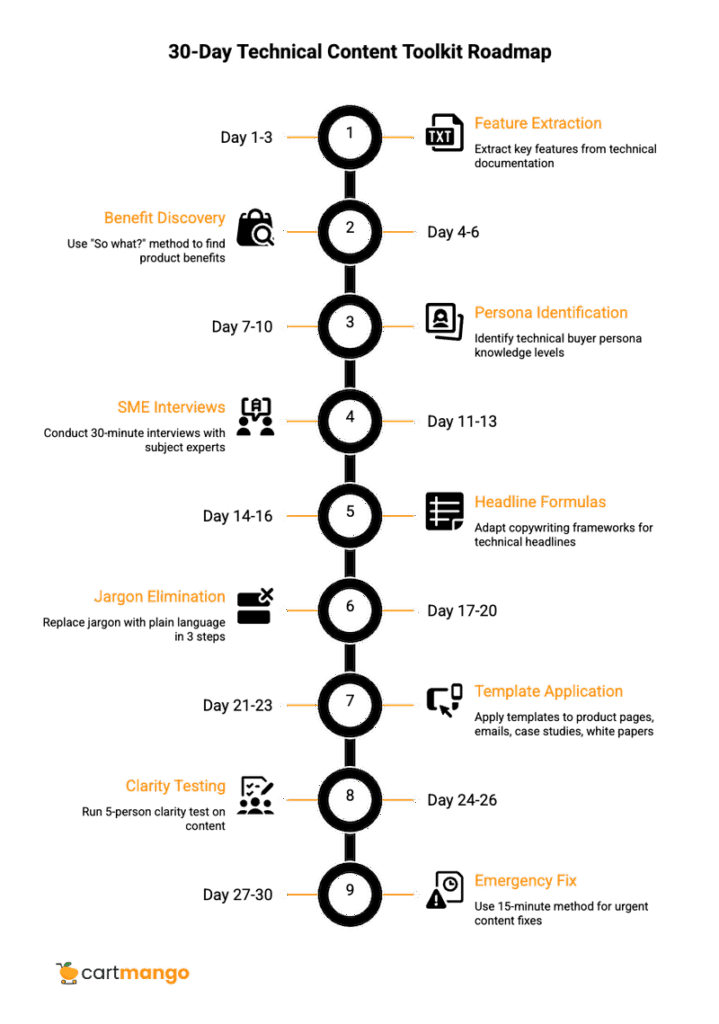
Ever stared at a technical product description and felt your brain short-circuit? You’re not alone.
I’ve spent countless hours banging my head against the wall trying to turn complex technical features into copy that actually sells.
Tech copywriting doesn’t have to be this hard.
This 30-day plan gives you exactly what you need:
12 templates and 12 processes to transform how you write about technical products/services.
No fluff. No theory. Just practical tools you can use today.
Tech companies with clear messaging see higher conversion rates than competitors with confusing technical jargon. Clear copy directly impacts your bottom line.
Day 1-3: The 15-Minute Method
The first challenge in tech copywriting is actually understanding what you’re selling.
Most product briefs are written by engineers who know everything about how it works but little about why customers should care.
Use the table below to extract what actually matters about your product in just 15 minutes.
Quick-Start Product Assessment | Your Notes | Example: Cloud Security Platform |
|---|---|---|
Core Problem: What specific pain point does this solve? | Businesses struggle to protect their cloud environments without specialized security expertise | |
Key Technical Feature #1 | Automated threat detection with machine learning algorithms | |
…Translated to Customer Benefit | Detects threats 4x faster than human analysts with 24/7 coverage | |
Key Technical Feature #2 | Centralized policy management across multi-cloud environments | |
…Translated to Customer Benefit | Manage all cloud security from one dashboard, reducing admin time by 70% | |
Key Technical Feature #3 | API-based integration with existing security tools | |
…Translated to Customer Benefit | Works with your current tools without replacing them, deployment in days not months | |
Primary Technical Audience | IT Security Teams | |
Secondary Non-Technical Audience | CFOs and Risk Management Executives | |
One-Sentence Value Proposition | Protect your cloud assets automatically without hiring expensive specialists |
The secret is simple: focus on the core problem first. What pain keeps your customers up at night?
For a cloud security platform, it’s not about the technical specs. It’s about how businesses without security expertise can protect their cloud environments.
Next, identify three key technical features. But don’t stop there. This is where most tech marketers go wrong.
For each feature, ask “So what?” until you reach a clear customer benefit. Your automated threat detection isn’t just smart technology – it finds threats 4x faster than humans and works 24/7.
This translation process shifts the conversation from what your product does to what your customer gets. That’s what sells.
The “explain it to your grandparent” technique works wonders here. If your grandparent can’t understand your product description, neither will busy executives making buying decisions.
Try this:
- Write your current product description on a piece of paper.
- Call your least technical friend and read it to them.
- Ask them to explain it back to you. The gaps in their explanation show you exactly where your copy needs work.
Day 4-6: The Tech-to-English Translation System
Technical Feature | Customer Benefit | Proof Point |
|---|---|---|
256-bit AES encryption | Peace of mind that sensitive customer data remains protected | Zero breaches across 10,000+ customers since 2018 |
API with 99.99% uptime | Reliable service your customers can access 24/7 | Average of only 4.38 minutes of downtime per month |
Microservices architecture | Faster feature updates without system-wide disruptions | New features deployed weekly vs. quarterly |
Automated regression testing | Fewer bugs after updates mean less frustration | 78% reduction in post-update support tickets |
Multi-tenant cloud deployment | Lower infrastructure costs with no performance sacrifice | Average customer saves $127,000 annually on hardware |
I watched a technical founder pitch his database solution by talking about query performance for five minutes straight. Not a single person in the room cared. When I asked “So what does that mean for users?” everything changed.
Take “256-bit AES encryption”:
- Your first “So what?” might yield “Your data is secure.”
- But that’s still too vague. A second “So what?” gets you to “Your sensitive customer information stays protected.”
- A third “So what?” reveals the emotional benefit: “Peace of mind knowing your customer data is safe.”
Now you’re talking about something customers actually care about.
The table above provides a framework for translating technical features into benefits backed by proof.
When writing about cloud infrastructure, don’t say “multi-tenant architecture.” Say “You’ll cut hardware costs by an average of $127,000 annually.” That’s specific and meaningful.
Folks are more likely to remember benefits than features, but the benefits must be concrete and specific to be effective.
Here’s your homework:
- List your product’s top 5 technical features.
- For each one, ask “So what?” three times until you reach a benefit that addresses an emotional need like saving time, reducing stress, or gaining status.
Day 7-10: The 7-Point Tech Audience Shortcut
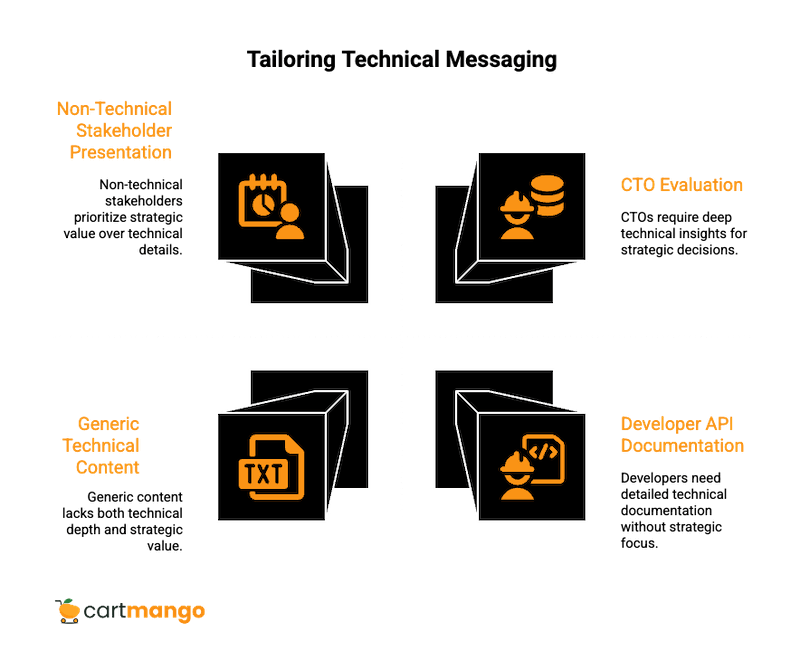
Different technical audiences need different messages.
The mistake I see over and over is writing everything for one generic “technical” reader.
Create a quick technical buyer persona worksheet that answers these questions:
- What’s their job title?
- What do they already know about this technology?
- What problem are they trying to solve?
- What technical terms do they use daily?
- What business metrics are they responsible for?
- Who do they need to convince to make a purchase?
- What objections will they raise?
For example, a CTO evaluating a cloud platform cares about scalability and security. A developer using the same platform cares more about the API and integration options.
Your messaging must adapt accordingly.
Include enough technical depth to establish credibility but focus primarily on strategic value.
For non-technical stakeholders (who often control the budget), focus on business outcomes and ROI.
You can use tools like UserTesting to gather insights about your technical audience more systematically.
Try creating a knowledge spectrum for your audience, rating their familiarity with key concepts from 1-10. This helps you calibrate your language precisely.
Day 11-13: Subject Matter Expert Interview Kit
The best tech copy comes from successful interviews with subject matter experts.
But these interviews often go wrong. Engineers dive too deep into technical details that don’t matter to customers.
Here’s the solution: a structured interview framework with 12 key questions that keep the conversation focused on what matters for copywriting:
- What problem does this feature solve for users?
- How were users solving this problem before?
- What’s the biggest misconception people have about this technology?
- If you had to explain this feature to a non-technical friend, what would you say?
- What’s one specific example of how a customer is using this feature?
- What metrics or results can customers expect?
- What technical objections do prospects usually raise?
- What unique approach did we take compared to competitors?
- What’s the minimum technical knowledge someone needs to use this?
- What’s your favorite customer success story related to this feature?
- What questions do customers ask most frequently?
- If we had to remove everything but one capability, what should we keep?
These questions extract information you can actually use in your copy. They guide technical experts away from implementation details and toward customer benefits.
The 30-minute technical interview process works like this:
Send these questions in advance, schedule exactly 30 minutes, and keep the conversation moving. Record the session so you can focus on follow-up questions instead of taking notes.
Day 14-16: Tech Copy Formula Swipe File
You don’t need to reinvent the wheel for every piece of technical copy.
Proven formulas work because they match how human brains process information.
When my brain feels like mush after hours of working with technical information, I turn to these formulas to create structure out of chaos.
Here are 5 headline formulas for technical products:
- The How-To: “How to [Achieve Desired Outcome] Without [Common Pain Point]”
Example: “How to Secure Your Cloud Data Without a Dedicated Security Team” - The Numbered List: “[Number] Ways to [Solve Problem] Using [Your Product Category]”
Example: “7 Ways to Cut Development Time Using CI/CD Automation” - The Question: “Are You Making These [Common] Mistakes With [Technical Process]?”
Example: “Are You Making These Database Indexing Mistakes That Slow Your App?” - The Before/After: “Transform Your [Current State] into [Desired State]”
Example: “Transform Your Manual Testing Process into an Automated Quality System” - The Problem-Agitation-Solution: “[Common Problem]? Discover How [Solution] [Delivers Result]”
Example: “Cloud Costs Out of Control? Discover How Our Optimizer Reduces AWS Bills by 40%”
These work because they focus on the reader’s needs rather than product features.
Take the Problem-Agitation-Solution (P.A.S.) framework. For a cloud computing platform, it looks like this:
- Problem: “Managing multiple cloud environments is complex and expensive.”
- Agitation: “Without unified management, you waste hours toggling between dashboards, risk security holes, and pay for resources you don’t use.”
- Solution: “Our platform gives you one control center for all cloud resources, cutting management time by 70% and typical cloud bills by 30%.”
Try rewriting your current headlines using these formulas. Track which ones perform best.
You can test your headlines with this tool to improve their effectiveness before publishing.
Day 17-20: The Jargon Elimination System
Technical jargon kills conversion rates.
But fixing it isn’t always easy.
Some technical terms are necessary for credibility.
Technical Term | Plain Language Alternative | Why It Works Better |
|---|---|---|
“End-to-end encryption” | “Your data is protected from the moment you send it until it’s received” | Explains the outcome rather than the mechanism |
“Serverless architecture” | “We handle all the backend infrastructure so you don’t have to” | Focuses on the benefit rather than the technology |
“Machine learning algorithm” | “Pattern recognition system that improves over time” | Describes function rather than using buzzwords |
“API integration capability” | “Connects smoothly with your existing tools” | Addresses the practical benefit to the user |
“Multi-factor authentication” | “Multiple security checkpoints to verify your identity” | Conveys the concept through familiar imagery |
“Asynchronous processing” | “Works on multiple tasks simultaneously” | Simplifies the technical concept |
“Microservices framework” | “Modular system that’s easily updated” | Emphasizes the business advantage |
Use this 3-step process to eliminate unnecessary jargon:
- Identify technical terms in your copy
- For each term, ask: “Will my primary audience understand this instantly?”
- If not, either replace it or explain it immediately afterward
The table above gives you ready-to-use translations for common technical terms. Notice how the plain language alternatives focus on what the technology does for the user, not how it works.
For example, instead of “asynchronous processing,” say “works on multiple tasks simultaneously.” The first term requires technical knowledge; the second one makes the benefit instantly clear.
Try this exercise:
Take your current homepage or product description and highlight every technical term. Show it to someone outside your industry. Any term they don’t immediately recognize needs translation.
Plain Language offers great resources to help you simplify technical language without dumbing it down.
Day 21-23: Tech Copy Templates For Different Channels
Different channels require different approaches to technical content.
What works for a white paper fails miserably in an email.
Channel | Format & Length | Key Elements | Special Considerations | Example |
|---|---|---|---|---|
Product Page | 300-500 words per section | – Hero headline with benefit | Scannable format with clear CTAs throughout | “Quick Setup Automation Hub: Deploy in minutes, not weeks” |
Email Campaign | 5 emails, 150-300 words each | – Subject line with specific value | Match technical depth to funnel stage | “Your data migration plan is ready (see results)” |
Case Study | 800-1200 words | – Problem statement | Balance technical accuracy with story | “How Financial Firm X secured 10,000 endpoints in 3 days” |
White Paper | 2000-3000 words | – Executive summary | Provide both overview and deep dive sections | “The Complete Guide to Zero-Trust Network Security” |
Technical Blog | 800-1500 words | – Practical headline | Focus on one specific use case | “5-Step Process for Automating Your CI/CD Pipeline” |
For product pages, the key is scannable content with a clear hierarchy. Technical buyers scan rather than read-they want to find specific information quickly. Use a strong benefit-focused headline, 3-5 feature/benefit blocks, a technical specifications table, and social proof elements.
Email campaigns require a different approach. Keep each email focused on a single idea, with progressive technical depth as the sequence advances. Subject lines must signal specific value, not generic benefits.
Case studies for technical products need to balance storytelling with technical substance. Structure them around Problem → Solution → Results, with a technical depth appropriate for your audience.
Apply these templates to your highest-priority content needs first.
You’ll be surprised how much faster you can create effective content when you start with a proven structure.
Technical B2B buyers engage with an average of 13 content pieces before purchasing, making an integrated, channel-appropriate approach important.
Day 24-26: The 2-Hour Tech Copy Testing Plan
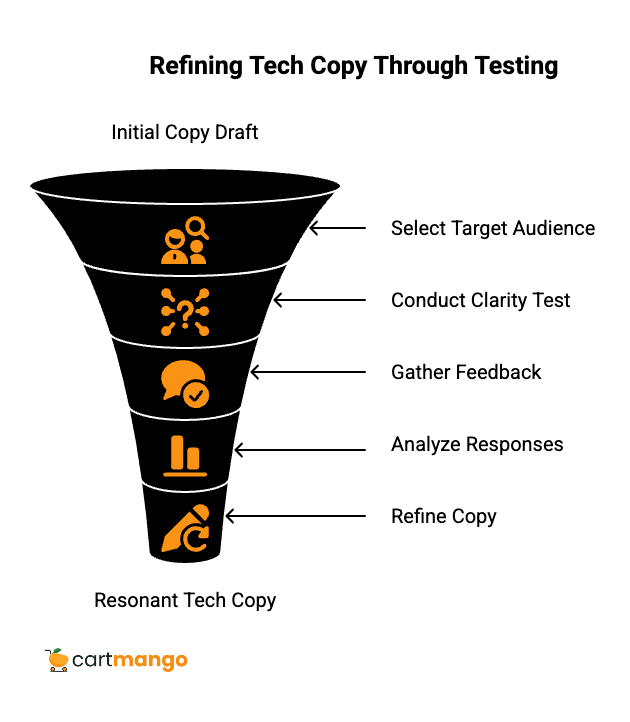
Even expert copywriters can’t predict which messages will resonate best with technical audiences. Testing is key.
You don’t need complex tools or big budgets. Start simple.
My favorite quick test is the “5-person clarity test.” Show your copy to 5 people who match your target audience. Ask them three questions:
- What is this product?
- What problem does it solve?
- Why should you care?
If they can’t answer clearly, your copy isn’t working.
For A/B testing, focus on these high-impact elements first:
- Headlines (technical vs. benefit-focused)
- Call-to-action text (specific technical value vs. generic action)
- Feature presentation order (what comes first matters most)
- Technical depth (how much technical detail to include)
Create your first A/B test today. Pick your most important landing page and test one element. Keep everything else identical to ensure valid results.
You can get started with tools like Hotjar to understand how users interact with your content before investing in more sophisticated testing platforms.
Day 27-30: Tech Copy Rescue Toolkit
Sometimes you inherit technical content that’s already live but performing poorly. You need quick fixes.
I felt sick looking at the analytics for a client’s technical product page. Visitors were arriving but bouncing immediately-the page was clearly failing, but a complete rewrite wasn’t possible due to approval timelines.
The 15-minute emergency fix method focuses on these high-impact changes:
- Replace the headline with a clear benefit statement
- Add subheadings that outline the key benefits
- Convert feature paragraphs to bullet points
- Add specific numbers and results
- Clarify the call to action
For a failing product description, start by creating a technical copy audit checklist that evaluates:
- Clarity of the main value proposition
- Balance of features vs. benefits
- Use of jargon and technical terminology
- Presence of proof points and evidence
- Call-to-action effectiveness
This is what usually happens: while the technical information was accurate, there was no clear path for non-developers to understand the business value. Adding a “Business Benefits” section at the top improved conversion rates.
Perform a rescue operation on your worst-performing content piece. Look at pages with high traffic but low conversion rates. These are prime candidates for the rescue toolkit.
Tools like Hemingway App can quickly identify readability issues in your technical content, highlighting sentences that are too complex or hard to understand.
Minimum Viable Tech Copy Framework
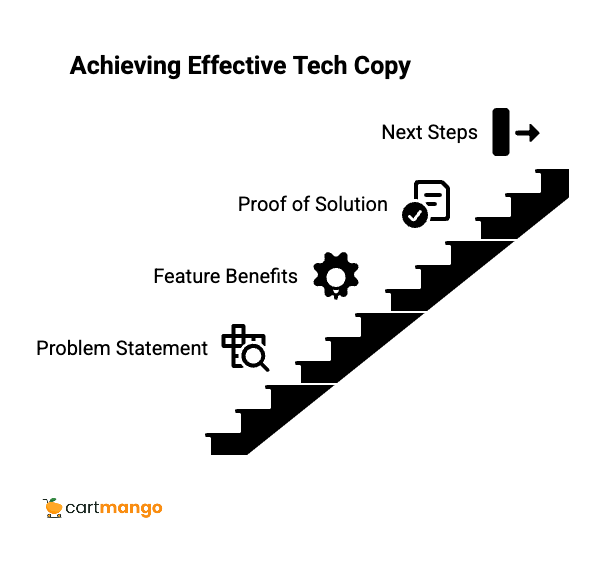
Sometimes perfect is the enemy of good enough.
When deadlines loom, you need a framework for creating effective technical content. Quickly.
The minimum viable tech copy approach focuses on the key elements that drive conversions.
For any technical content piece, make sure you have:
- A clear statement of the problem you solve
- Your 3 most important technical features translated to benefits
- Specific proof that your solution works
- A clear next step for the reader
When time is tight, focus on creating a strong foundation rather than comprehensive content. You can always add depth in future iterations.
The important thins is identifying what content users absolutely need to move forward. For technical products, this usually includes:
- Enough information to understand the value proposition
- Basic implementation requirements
- Evidence that the solution works
- Clear instructions for next steps
Agile content creation methodologies provide additional frameworks for creating useful content under tight deadlines. Go here if you want to learn more.
Tech-to-Visual Translation Guide
Technical concepts often work better as visuals than words. The challenge is choosing the right type of visualization for different concepts.
Technical Concept | Best Visualization Type | Why It Works | Example Application |
|---|---|---|---|
Complex Process/Workflow | Flowchart | Shows sequence and relationships clearly | API data routing process |
System Architecture | Diagram with labeled components | Illustrates connections between parts | Cloud infrastructure setup |
Performance Comparison | Bar or line graph | Makes numerical differences immediately visible | Speed benchmarks vs competitors |
Feature Relationships | Mind map | Shows how different elements connect | Product ecosystem visualization |
Data Security Layers | Concentric circles | Conveys the concept of protection layers | Security defense model |
Abstract Concept | Metaphor illustration | Makes intangible concepts tangible | Machine learning as a brain growing |
Cost/Benefit Analysis | 2×2 matrix | Helps visualize value vs. investment | ROI of implementation options |
The worst technical presentation I ever sat through was 45 minutes of dense text slides about a complex architecture. My eyes glazed over. When the presenter finally showed a simple diagram, everything suddenly made sense.
Use the table above to select the right visualization type for different technical concepts.
E.g. System architectures work best as component diagrams, while performance comparisons need clear charts.
You don’t need design skills to create effective technical visuals. Tools like Canva, Lucidchart, and even Google Slides have templates you can adapt.
When explaining API data routing, a simple flowchart can replace paragraphs of technical explanation. For security concepts, concentric circles effectively show protection layers without requiring technical knowledge.
Try this and let me know how it goes:
Identify 3 concepts in your current copy that customers struggle to understand. Create simple visuals using the matched visualization type from the table.
Cross-Team Collaboration Blueprint
Technical copy often fails in the review process:
- Marketing writes copy that engineering says is inaccurate
- Engineering suggests revisions that marketing says will never convert
Marketing and engineering speak different languages, resulting in watered-down copy that pleased no one.
The solution is a structured review process with clear roles:
- Marketing owns conversion and clarity
- Product owns accuracy and completeness
- Sales owns customer relevance
- Legal owns compliance and claim substantiation
Create feedback loops with specific questions for each reviewer:
- Ask engineers: “Is this technically accurate?” (not “Would you write it this way?”)
- Ask marketing: “Will this support our conversion goals?” (not just “Do you like it?”)
- Ask sales: “Will this address customer objections?” (not just “Will this sell?”)
Map your current workflow and identify the bottlenecks. Often the problem isn’t the people but the process.
Tech Copy Scoring System
You can’t improve what you don’t measure.
The Tech Copy Scoring System gives you a framework to evaluate your technical content objectively.
Criteria | 1-3 (Needs Work) | 4-7 (Good) | 8-10 (Excellent) |
|---|---|---|---|
Technical Accuracy | Contains errors or misrepresentations | Generally accurate with minor imprecisions | 100% accurate with proper context |
Clarity | Relies heavily on jargon, confusing structure | Understandable but requires some technical knowledge | Clear to both technical and non-technical readers |
Benefit Focus | Features listed without connecting to outcomes | Benefits mentioned but not emphasized | Strong connection between features and specific benefits |
Audience Match | Generic messaging not tailored to audience | Some customization for technical level | Perfectly matched to audience’s technical knowledge |
Scannability | Dense text blocks, few headings | Some structure, basic headings | Strategic headings, bullets, visual hierarchy |
Proof Elements | Claims without evidence | Some proof points included | Specific metrics, testimonials, and demonstrations |
Call to Action | Vague or missing next steps | Basic next step provided | Clear, specific action tailored to buyer journey stage |
Visual Support | No visuals to explain concepts | Basic visuals included | Strategic visuals that clarify complex concepts |
Technical Differentiation | No clear technical advantage communicated | Some differentiation from competitors | Clear positioning of unique technical strengths |
Readability | Requires multiple readings to comprehend | Requires some concentration but understandable | Effortless to read and comprehend |
Use the scoring matrix above to rate your content on 10 key dimensions. Score each criteria from 1-10, with detailed definitions for what constitutes needs work (1-3), good (4-7), and excellent (8-10) content.
Examples:
- The “Technical Accuracy” dimension rates content based on factual correctness and proper context.
- “Benefit Focus” evaluates how well technical features connect to customer outcomes.
You can have high technical accuracy scores (8-9) but low benefit focus scores (2-3). This shows exactly what needs improvement.
The audit process is simple:
- Select 3-5 key content pieces
- Score each piece against all 10 criteria
- Identify patterns of strength and weakness
- Prioritize improvements based on low scores
Try scoring three pieces of your current tech content. The patterns will quickly reveal your copywriting blind spots.
You can use tools like Buzzsumo to measure content effectiveness.
The Evolving Landscape of Technical Copywriting
Differentiating Roles in the Tech Industry
Let’s talk about what’s actually happening in the technology industry right now.
Technology copywriting has transformed from a niche skill to a must-have for technology companies of all sizes.
10 years ago, tech brands viewed copywriting as an afterthought. Now, the smartest companies see it as central to their marketing communication strategy.
The difference between a technical copywriter and a technical writer often confuses people. A technical writer typically focuses on documentation, user guides, and instruction manuals. Their primary goal is accuracy and clarity, not persuasion.
A technology copywriter, on the other hand, creates compelling copy that drives action. They translate complex features into benefits that move potential customers through the sales process.
Real-World Impact on Tech Businesses
A friend once shared his experience working with a software startup co-founder.
The co-founder initially tried using their technical writer for marketing materials. The content was accurate but generated zero leads.
When he brought in a dedicated technical copywriter, their conversion rate jumped 40% in 3 weeks.
Technical content writing combines elements of both roles-educational value with persuasive elements. It’s particularly effective for tech websites, blog content, and other forms of top-funnel content.
Tips for Technology Companies
Resource Allocation for Smaller Businesses
Most technology products struggle to connect with their target market because the people creating them are too close to the technology.
You need someone who can bridge that gap.
Smaller businesses often think they can’t afford specialized copywriting services. In reality, they can’t afford not to invest in them. Poor copy means fewer conversions and ultimately more sales lost.
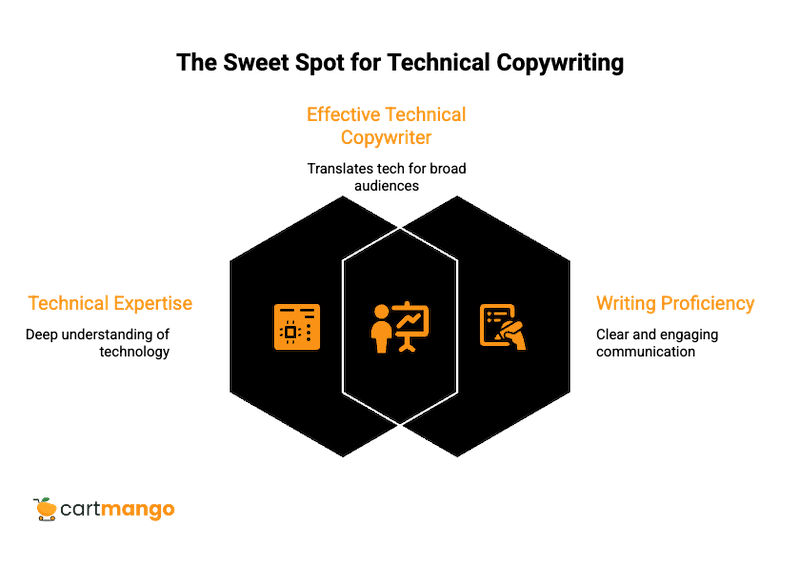
Finding the Right Talent for Technical Products
I’ve seen other businesses try to have general content writers handle technical topics. Without specific skills in translating technical concepts, these writers often produce content that’s either too basic or too jargon-heavy for the average reader.
When hiring a technology copywriter, look beyond their writing samples.
The best technical copywriters excel at conducting interviews with subject matter experts. They ask questions that extract valuable insights other copywriters might miss.
Balancing Technology (AI) and Human Expertise
Artificial intelligence tools are changing how we approach first drafts, but they still struggle with the nuances of technical copywriting.
Use them for generating ideas and basic structure, but rely on human expertise for the final product.
For tech products with complex features, focus your copywriting work on creating concise content that offers a clear understanding of benefits. Most website content fails because it emphasizes specifications without explaining why they matter.
Measuring Copywriting Effectiveness
The best tech companies use specific tools to measure how their copywriting affects lead generation.
Track not just traffic and clicks but how your content moves visitors toward a deeper understanding of your products and services.
Compelling copy is about making complex products simple for potential customers.
The goal is never to impress other copywriters, but to drive action from your target market.
Quick Start Tech Copywriting Plan
No need to implement everything at once.
Start with this 7-day plan to see immediate improvements:
Day 1:
Complete the product understanding framework for your main product. Focus on translating your 3 most important features into clear benefits.
Day 2:
Create one feature-benefit-proof connector using the translation system. Make sure you can articulate why customers should care about your key features.
Day 3:
Run a 15-minute technical complexity assessment on your homepage or main product page. Identify jargon that needs translation.
Day 4:
Apply one headline formula to your main product page. Test the before/after with a colleague or customer.
Day 5:
Interview one subject matter expert using the questions provided. Focus on extracting customer-focused information rather than technical details.
Day 6:
Set up a simple A/B test on your main landing page. Test a technical headline against a benefit-focused one.
Day 7:
Choose one template from the channel section and apply it to your highest-priority content need.
–
This approach prevents overwhelm and builds momentum through quick wins. Each day’s task should take no more than 60 minutes.
The most powerful thing about this system is that it’s cumulative. Small improvements compound over time into dramatically better technical copy.
Related
- Sellfy vs Payhip: The Recurring Revenue Prison (2026)
- Podia vs Gumroad: The Recurring Revenue Handcuffs (2026)
- SendOwl vs Gumroad: The Recurring Revenue Black Hole (2026)
- Gumroad vs Sellfy: The Vendor Lock-in Cage (2025)
- Gumroad vs Payhip: The Hidden Trap for Creators (2025)
- ThriveCart vs SamCart – The Subscription Hostage Trap (2025)
- 8 ThriveCart Alternatives & The Lifetime Pricing Paradox (2025)
- 8 SamCart alternatives + Subscription hostage (2025)
- The GENTLE Method: Soft marketing for creators
- How Far in Advance Should You Promote a Webinar?
